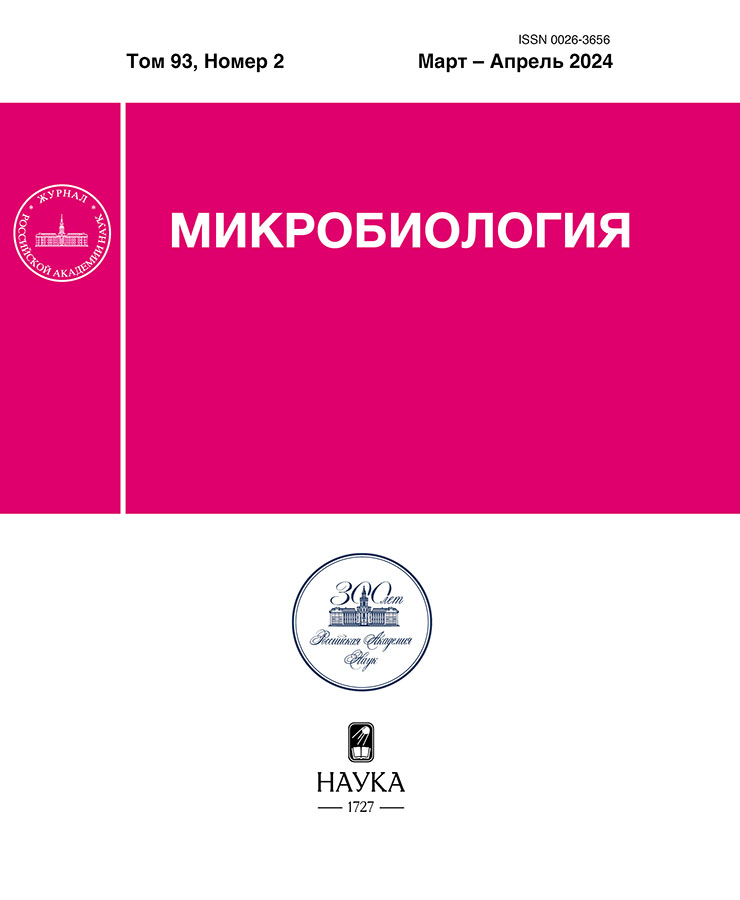Rhodococcus qingshengii GlMm1 as the Basis of a Biosensor for Determination of the Fungicide Carbendazim
- Autores: Kuvichkina T.N.1, Kaparullina E.N.1, Doronina N.V.1, Reshetilov A.N.1
-
Afiliações:
- G.K. Skryabin Institute of Biochemistry and Physiology of Microorganisms, Federal Research Center “Pushchino Scientific Center for Biological Research of the Russian Academy of Sciences”
- Edição: Volume 93, Nº 2 (2024)
- Páginas: 145-148
- Seção: SHORT COMMUNICATIONS
- URL: https://edgccjournal.org/0026-3656/article/view/655125
- DOI: https://doi.org/10.31857/S0026365624020086
- ID: 655125
Citar
Texto integral
Resumo
The possible application of Rhоdococcus qingshengii strain GlMm1, isolated from a Dead Sea clay sample, as the basis of a biosensor for determining the benzimidazole fungicide carbendazim was investigated. High sensitivity of the biosensor under neutral pH and up to 500 mM NaCl at 2 to 160 μM carbendazim was maintained for up to 30 days.
Palavras-chave
Texto integral
Sobre autores
T. Kuvichkina
G.K. Skryabin Institute of Biochemistry and Physiology of Microorganisms, Federal Research Center “Pushchino Scientific Center for Biological Research of the Russian Academy of Sciences”
Email: lenokap80@gmail.com
Rússia, Pushchino, 142290
E. Kaparullina
G.K. Skryabin Institute of Biochemistry and Physiology of Microorganisms, Federal Research Center “Pushchino Scientific Center for Biological Research of the Russian Academy of Sciences”
Autor responsável pela correspondência
Email: lenokap80@gmail.com
Rússia, Pushchino, 142290
N. Doronina
G.K. Skryabin Institute of Biochemistry and Physiology of Microorganisms, Federal Research Center “Pushchino Scientific Center for Biological Research of the Russian Academy of Sciences”
Email: lenokap80@gmail.com
Rússia, Pushchino, 142290
A. Reshetilov
G.K. Skryabin Institute of Biochemistry and Physiology of Microorganisms, Federal Research Center “Pushchino Scientific Center for Biological Research of the Russian Academy of Sciences”
Email: lenokap80@gmail.com
Rússia, Pushchino, 142290
Bibliografia
- Китова А.Е., Кувичкина Т.Н., Аринбасарова А.Ю., Решетилов А.Н. Деградация 2,4-динитрофенола свободными и иммобилизованными клетками Rhodococcus erythropolis HL PM-1 // Прикл. биохим. микробиол. 2004. Т. 40. С. 307‒311.
- Kitova A.E., Kuvichkina T.N., Arinbasarova A.Y., Reshetilov A.N. Degradation of 2,4-dinitrophenol by free and immobilized cells of Rhodococcus erythropolis HL PM-1 // Appl. Biochem. Microbiol. 2004. V. 40. P. 258–261.
- Кувичкина Т.Н., Будина Д.В., Олькова А.С., Решетилов А.Н. Оценка присутствия ди-(2-этилгексил)фталата в поливинилхлоридных пластикатах масс-спектрометрическим и биосенсорным методами // Теоретическая и прикладная экология. 2015. № 4. С. 11‒15.
- Патент на полезную модель 2015. № 156 546.
- Belova A.A., Kaparullina E.N., Agafonova N.V., Grouzdev D.S., Kopitsyn D.S., Machulin A.V., Doronina N.V. Ancylobacter crimeensis sp. nov., a new species of aerobic methylotrophic bacteria isolated from Oak phyllosphere // Microbiology (Moscow). 2023. V. 92.P. 598–608.
- Fang H., Wang Y., Gao C., Yan H., Dong B., Yu Y. Isolation and characterization of Pseudomonas sp. CBW capable of degrading carbendazim // Biodegradation. 2010. V. 21. P. 939–946.
- Pande G. Domian S.J., Russell R.J., Brearley C., Kotsonis S., Cakeshott J.G. Cloning and biochemical characterization of a novel carbendazim (metyl-1H-benzimidazol-2-ylcarbamate)-hydrolyzing esterase from newly isolated Nocardiodes sp. strain SG-4G fnd its potential for use ln enzymatic bioremediation // Appl. Environ. Microbiol. 2010. V. 75. P. 2040‒2945.
- Singh S., Singh N., Kumar V., Datta S., Wani B., Singh D., Singh K., Singh J. Toxicity, monitoring and biodegradation of the fungicide carbendazim // Environ. Chem. Lett. 2016. V. 14. Р. 317‒329.
- Xu J.L., He J., Wang Z.C., Wang K., Li W.J., Tang S.K., Li S.P. Rhodococcus qingshengii sp. nov., a carbendazim-degrading bacterium // Int. J. Syst. Evol. Microbiol. 2007. V. 57. Р.2754‒2757.
- Zhang M., Bai X., Li Q., Zhang L., Zhu Q., Gao S., Ke Zh., Jiang M., Hu J., Qiu J., Hong Q. Functional analysis, diversity and distribution of carbendazim hydrolases Mhel and CbmA, responsible for the initial step in carbendazim degradation // Environ. Microbiol. 2022. V. 24. P. 4803‒4817.
Arquivos suplementares












